How Often To Water An African Violet
-
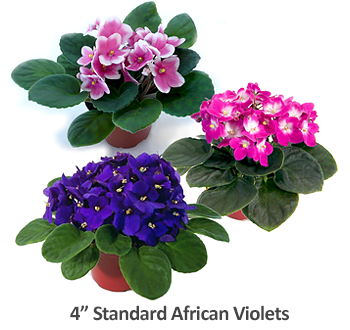 African Violet Intendance: Basic Summary Lite: Moderate to vivid, indirect, indoor light.
African Violet Intendance: Basic Summary Lite: Moderate to vivid, indirect, indoor light. Watering:
Keep soil moist to dry out, and permit soil effectually roots to dry out before watering to encourage blooming. Water from the bottom with room temperature water by placing the plastic grower's pot in water, and assuasive the institute to absorb the water ( not more than than 30 minutes ).
Avoid getting water on the leaves as this can cause spotting damage. For best results, use violet plant food as directed.Tips:
Pinch off spent blossoms and blossom stems to encourage development of new blooms. Place plants abroad from floor vents, fans, or archway doors to avert air drafts and bursts of cold air.

Water
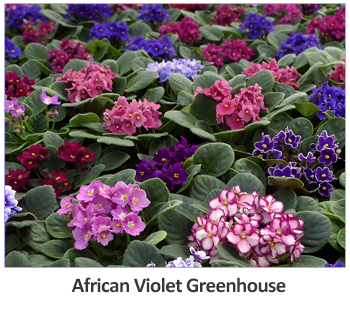 In general, African Violets need just plenty water to go on the soil moist, simply never soggy. Also much waterwill leave your African Violets susceptible to such deadly pathogens as Pythium, Root Rot and Crown Rot. Overwatering tin can likewise cause denitrification, a condition which prevents plants from getting the nitrogen they need.
In general, African Violets need just plenty water to go on the soil moist, simply never soggy. Also much waterwill leave your African Violets susceptible to such deadly pathogens as Pythium, Root Rot and Crown Rot. Overwatering tin can likewise cause denitrification, a condition which prevents plants from getting the nitrogen they need. The h2o should be room temperature, or as close as possible in temperature to the air effectually your plants. When the h2o is as well cold, it chills the roots of African Violets, causing leaves to curl down as the water is absorbed into the institute. Also, if watering from the superlative, common cold h2o can crusade leaf spotting. Such spots represent a form of necrosis and, every bit such, cannot be removed. (Annotation: Whether the water is the correct temperature or non, it is e'er important not to get water on the leaves. The only exception to this is when you are spray misting for purposes of quick-feeding or increasing the humidity effectually your plants. Such misting will non leave behind the big water aerosol which, when exposed to the sunday, volition produce brown spots on the leaves.)
Never apply soft water. Soft h2o increases the saline content. This will modify both the pH and the electrical conductivity of the soil, thereby diminishing your African Violet'south ability to absorb water and nutrients. If you have soft water, you lot may be able to divert water before it reaches the softening unit. If not, yous will need to seek an alternative source of water.
Avoid using highly chlorinated water. While some chlorine is really necessary for photosynthesis to occur, African Violets demand very trivial, i.e., 70-100 ppm. Such minute traces in the h2o will not be discernible by smell. In fact, if you tin odour chlorine, then your h2o has as well much. The consequences of using water with likewise much chlorine in information technology include leaf fire and diminished flowering. If you have highly chlorinated water, and no alternative source is available, dispense water into a container and let stand overnight to allow the chlorine gas to escape.
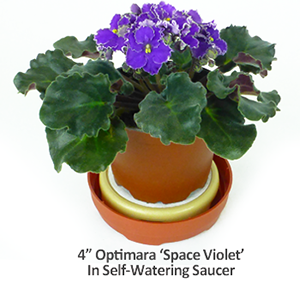 To insure correct watering, you are strongly encouraged to use a recommended cocky-watering device, such as the Optimara MaxiWell (for iv-inch standard Violets), MiniWell (for 1-inch super miniatures) or the Optimara WaterShip container, a spill-proof, self-watering device for 2-inch miniatures. By providing the correctamount of water, a good self-watering device will greatly reduce the chances of getting whatever of the deadly fungi which cause plants to rot. In add-on, because a good self-watering device waters from the bottom, it eliminates the potential hazards of watering from the top, i.east., leaf spots.
To insure correct watering, you are strongly encouraged to use a recommended cocky-watering device, such as the Optimara MaxiWell (for iv-inch standard Violets), MiniWell (for 1-inch super miniatures) or the Optimara WaterShip container, a spill-proof, self-watering device for 2-inch miniatures. By providing the correctamount of water, a good self-watering device will greatly reduce the chances of getting whatever of the deadly fungi which cause plants to rot. In add-on, because a good self-watering device waters from the bottom, it eliminates the potential hazards of watering from the top, i.east., leaf spots.Finally, there are some self-watering devices which, while providing the benefits already mentioned, will too increase the humidity in the surface area immediately around your Violets. A self-watering device of this type, such as the Watermaid (for pot sizes upwardly to 5-ane/2 inches), stores water in an open saucer and draws h2o into the soil via capillary matting. All of the above self-watering devices are available online at the Selective Gardener, a mail social club supplier that specializes in plant intendance products fabricated specifically for African Violets.

Calorie-free Requirements
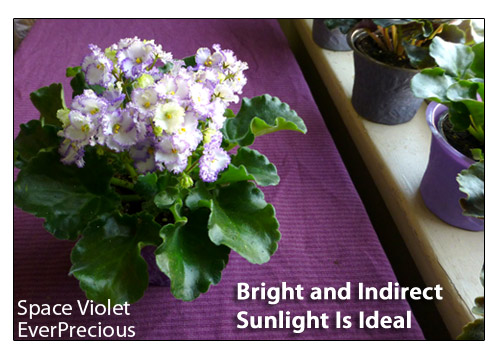 The amount of light that an African Violet receives is important for its health and overall performance. They thrive in moderate to vivid, indirect, indoor lite.
The amount of light that an African Violet receives is important for its health and overall performance. They thrive in moderate to vivid, indirect, indoor lite.
African Violets, like other plants, need light for photosynthesis. While photosynthesis is most oftentimes associated with a plant'southward dark-green leaves and stems, its most vital function is to convert carbon, hydrogen and oxygen (in the form of carbon dioxide and water) into usable free energy called found carbohydrates. Even when all the essential nutrients are bachelor to the institute, a complete absence of sunlight will literally issue in starvation.More common, of course, is a plant which but does not get plenty sunlight. In such circumstances, an African Violets will cease flowering and its leaves begin to turn yellowish. Information technology is also likely that the African Violet, which is not getting enough sunlight, will become rangy as information technology develops elongated leaves and stems.
While insufficient sunlight tin can be harmful, too much sunlight can as well crusade issues. Among other symptoms, also much sunlight will produce brown spots on the leaves and flowers. This is a form of necrosis analogous to sunburn. In addition, too much sunlight can cause the leaves to curl downwardly and may turn variegated leaves entirely dark-green.
 African Violets perform best when they receive a lot of indirect sunlight.
African Violets perform best when they receive a lot of indirect sunlight.
While African Violets will tolerate direct sunlight very early on or very tardily in the day, they should, in all other cases, be shielded from direct sunlight. For best results, identify your Violets in a window where they will receive light well-nigh of the day, i.e., a window with western or southern exposure. Adjust your blinds or use a sheer pall to filter out some of the light. If yous have access to a calorie-free meter, the correct luminosity for African Violets is ten,000 to 12,000 lux, or about 900 to 1100 foot candles. Every bit an alternative, you tin get a reasonable approximation of this lite value by simply holding your hand over a Violet during the fourth dimension when information technology is receiving the brightest light. If you can barely see the shadow of your manus over the Violet, then it is getting the correct amount of low-cal.
Proceed in mind that the elapsing and intensity of sunlight volition vary with the seasons. During the winter months, you may demand to allow your African Violets to get more sunlight than they would unremarkably receive. Besides, it is important to rotate your African Violets and then that they receive an equal amount of sunlight on all sides. They should be rotated i-quarter plough, about once a week or each time you lot water. If African Violets are non rotated in this way, they will begin to bend towards the light and grow larger on the side closest to the window. This reaction is not peculiar to African Violets. For almost all plants, information technology is but a phototropic response which allows a institute to get optimal sunlight.
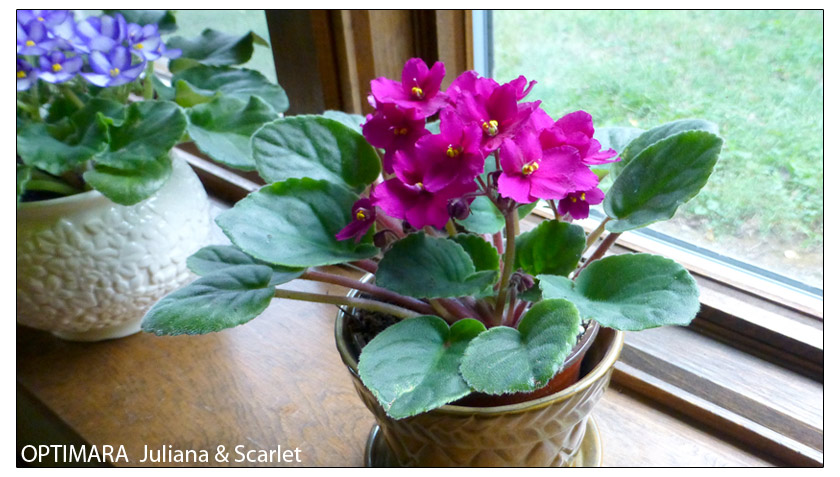 If yous apply artificial lighting, i.eastward., grow lights, your African Violets will exist subject to a number of special considerations. First, when selecting a grow light, information technology is of import to make sure it emits lite in both the carmine and blueish spectrums. Red light is essential for African Violets to bloom. Blue low-cal is necessary for photosynthesis to occur and, thus, is vital for the development of greenish leaves and the production of plant carbohydrates.
If yous apply artificial lighting, i.eastward., grow lights, your African Violets will exist subject to a number of special considerations. First, when selecting a grow light, information technology is of import to make sure it emits lite in both the carmine and blueish spectrums. Red light is essential for African Violets to bloom. Blue low-cal is necessary for photosynthesis to occur and, thus, is vital for the development of greenish leaves and the production of plant carbohydrates. Second, keep in mind that the intensity of light volition increase every bit the distance from the source decreases. For this reason, information technology is of import to mount your grow light at the proper distance higher up the plant. If the African Violet is besides close to the grow light, it will begin to develop symptoms similar to those resulting from besides much sunlight, i.e., leafage scorch. While you should give preference to any instructions accompanying your particular abound light, abound lights should generally be mounted 18 to 20 inches above the tops of standard African Violets. For miniatures, grow lights may need to exist lowered to near 10 to 12 inches higher up the tops of the plants.
Tertiary, information technology is of import to recall that African Violets need at least eight hours of darkness, each twenty-four hours, in guild to flower. While African Violets need a sufficient duration of light to produce florigen (floweringhormone), florigen itself does not trigger blooming until it is dark. For this reason, African Violets should receive light for no more than 16 hours a day. To properly regulate the duration of lite, you lot may want to consider getting a timer for your grow lights.
Finally, you should exist enlightened of a condition peculiar to African Violets which are cultivated under grow lights. This condition is called Foliage Bleaching. While not all African Violets are sensitive to this condition, those that are will develop leaves which are distinctly lighter on those areas directly exposed to the lite. Often, these lighter areas volition also exhibit a slight pinkish cast. The only way to care for this status is to cease using grow lights and begin using sunlight.

Temperature and Air Quality
 In terms of temperature, humidity and other factors of air quality, African Violets thrive in an environment which nigh people would consider pleasant. Therefore, if you feel comfortable, chances are, your African Violets are feeling comfortable besides. All the same, in case y'all are 1 of those people who thrive in otherwise unhealthy circumstances, you lot will need to know a little about the conditions preferred by African Violets.
In terms of temperature, humidity and other factors of air quality, African Violets thrive in an environment which nigh people would consider pleasant. Therefore, if you feel comfortable, chances are, your African Violets are feeling comfortable besides. All the same, in case y'all are 1 of those people who thrive in otherwise unhealthy circumstances, you lot will need to know a little about the conditions preferred by African Violets. In general, you should go along the air temperature, around your African Violets, equally close as possible to seventy degrees F. At the very least, practice not allow temperatures to drop below lx degrees or rise above 80 degrees. Also, while extreme variations in temperature should e'er be avoided, exercise not be concerned about slight fluctuations betwixt twenty-four hours and night-time temperatures. In fact, some African Violet hybrids require fluctuations of every bit much as ten degrees in society to produce optimal flowering. Nonetheless, if your African Violets are exposed to extreme temperatures, fifty-fifty for a very short period of time, they may suffer. When the temperature is too warm, plant growth will become rangy (i.e., elongated stems and leaves), leaves will appear dry out and shriveled, and flowers volition brainstorm to dropoff. If you lot know that the temperature is too warm, gradually reduce it to about 70 degrees F. While doing so, keep in listen that a change in temperature volition have a respective effect on transpiration and evaporation rates. Therefore, depending on how long your African Violet has been exposed to excessive heat, you may need to decrease the frequency with which information technology receives water. To judge the touch on water, it will help to know that the rate of evaporation from leaves drops past half with each subtract of 20 degrees F.
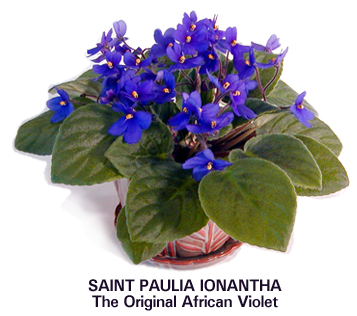 While excessive heat will crusade your African Violets to suffer, they are not nigh every bit deadly as cold temperatures. At the very to the lowest degree, African Violets will finish flowering, and constitute growth volition be slow. In more astringent cases, leaves and flowers will chop-chop begin to wilt, and the plant will become into shock. Moreover, libation temperatures go out African Violets vulnerable to such deadly pathogens as Crown Rot, especially when accompanied past excessive moisture. Depending on the extent to which your African Violet has been exposed to cold temperatures, yous may or may non exist able to save information technology. Once an African Violet begins to show symptoms of exposure, it is frequently too late, specially since it may take up to 36 hours for symptoms to announced.
While excessive heat will crusade your African Violets to suffer, they are not nigh every bit deadly as cold temperatures. At the very to the lowest degree, African Violets will finish flowering, and constitute growth volition be slow. In more astringent cases, leaves and flowers will chop-chop begin to wilt, and the plant will become into shock. Moreover, libation temperatures go out African Violets vulnerable to such deadly pathogens as Crown Rot, especially when accompanied past excessive moisture. Depending on the extent to which your African Violet has been exposed to cold temperatures, yous may or may non exist able to save information technology. Once an African Violet begins to show symptoms of exposure, it is frequently too late, specially since it may take up to 36 hours for symptoms to announced. If your African Violet has been exposed to cold temperatures, move it immediately to a place where the temperature is warm. Next, remove any tissue which has become night and mushy. This volition preclude the spread of rot. Discontinue watering and fertilizing, but maintain loftier humidity. Ane fashion to do this is to apply the bag method. Place your African Violet in a clear plastic pocketbook and shut the top with a wire twist. If your African Violet is going to survive, you volition brainstorm to come across signs of recovery within a few days. Yet, to let full recovery, y'all should keep the Violet bagged for well-nigh one week. At this fourth dimension, once you have removed it from the bag, it should be rubber to render your African Violet to its normal watering and fertilizing schedule.
As with relatively warm temperatures, humidity is vital to the health of African Violets. In their native habitat, in the Usambara Mountains of Eastward Africa, the relative humidity is more often than not about seventy to 80 percent. While this level of humidity would be difficult to maintain in most homes, you should try to provide your African Violets with at least 50 to sixty per centum humidity. If the level of humidity is much less than this, an African Violet's transpiration rate volition be greater than its ability to blot water. As a result, buds will neglect to open, constitute growth will exist ho-hum, and leaves will brainstorm to appear dry and shriveled.
If necessary, there are a number of ways to increase the amount of humidity around your African Violets. First, yous can create a favorable microclimate past grouping your African Violets together. This, by itself, tin increment the humidity around your plants past as much as fifteen percent. However, when doing then, it is important not to place your African Violets so
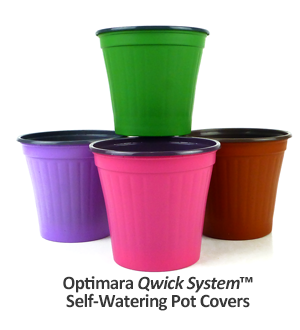 closely together that the leaves are touching. While maintaining high humidity is essential, information technology is also important to give your Violets enough room to grow and to maintain sufficient air circulation in order to forestall the growth of potentially dangerous fungi.
closely together that the leaves are touching. While maintaining high humidity is essential, information technology is also important to give your Violets enough room to grow and to maintain sufficient air circulation in order to forestall the growth of potentially dangerous fungi. Another way to increment humidity is to use a cocky-watering device, such as the Watermaid, which relies on capillary matting to draw h2o into the soil. Where capillary matting is used, depression humidity is rarely a trouble. A similar solution is to identify containers of water around the plants. As with capillary matting, evaporation increases the h2o content in the air surrounding your Violets.
Finally, y'all may merely want to consider using a humidifier. This will probably exist more necessary during the wintertime months than during than the summer. However, both heating and air conditioning can dry out the air to some extent. In the winter, use a warm-mist humidifier then that the increase in humidity does non touch on the air temperature. In the summer, employ a absurd-mist humidifier.
Because humidity is then important to African Violets, practiced air apportionment also becomes a vital concern. Maintaining skilful air circulation, peculiarly when the air is clammy, helps prevent the growth of such fungi as Botrytis and Powdery Mildew. However, be vigilant to any common cold drafts which come in contact with your African Violets. Even when the overall air temperature is inside acceptable limits, a common cold typhoon may eventually send an African Violet into shock. In many cases, this tin can be fatal. At the very least, a cold draft will often crusade African Violets to grow lopsided. When this is the case, the source of the draft should hands be located, since an African Violet will get smaller on the side closest to where the draft is originating. In about instances, the source of the draft will be the window in which the Violet has been placed.
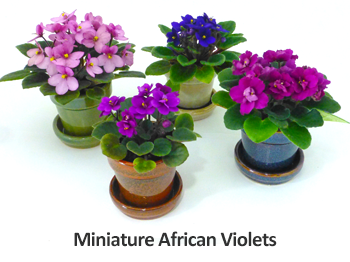 One cistron of air quality that is often overlooked is the presence of gas or chemical fumes. Common instances of these substances may be found in natural gas (i.e., from a gas stove or other gas-operated appliance), paint fumes or such solvents equally those contained in cleaning fluids. Depending on the precise source, gas or chemic fumes tin can event in pale leaves which are smaller than normal and flowers which plough chocolate-brown and drop off.
One cistron of air quality that is often overlooked is the presence of gas or chemical fumes. Common instances of these substances may be found in natural gas (i.e., from a gas stove or other gas-operated appliance), paint fumes or such solvents equally those contained in cleaning fluids. Depending on the precise source, gas or chemic fumes tin can event in pale leaves which are smaller than normal and flowers which plough chocolate-brown and drop off. Prolonged exposure to gas or chemic fumes may ultimately be fatal. For these reasons, information technology is important to insulate your African Violets from whatsoever source of gas or chemical fumes. If you doubtable that your African Violets are being exposed to one of these substances, it is vital that the source be isolated and remedied. This is as truthful for your African Violets as it is for y'all. In fact, if your African Violets are getting ill from the fumes, chances are, y'all will too.
I way to determine if gas or chemical fumes are nowadays has been suggested by the African Violet Club of America. They assert that a young tomato found, when in the presence of gas or chemical fumes, will begin to sag inside a few hours. Notwithstanding, even if you decide that such substances may be nowadays, it will however be necessary to locate the source and correct it. If unable to exercise so, you should be brash to contact a specialist, such as a natural gas technician.


"Like" United states on Facebook
for the Latest African Violet Updates & Exclusive Photos of New Varieties in Evolution!

To order any of the products discussed on this page, visit
Selective GardenerCopyright 1999-2002 Optimara/Holtkamp Greenhouses, Inc. Nashville, Tennessee. Doc Optimara, the Medico Optimara logo and Optimara Field Guide are trademarks of Holtkamp Greenhouses, Inc. Optimara, the Optimara logo, EverFloris, MiniWell, MaxiWell, WaterShip and Watermaid are trademarks of International Plant Convenance, A.G., Switzerland.
How Often To Water An African Violet,
Source: https://optimara.com/africanvioletcare1.html
Posted by: lopezbricip1961.blogspot.com


0 Response to "How Often To Water An African Violet"
Post a Comment